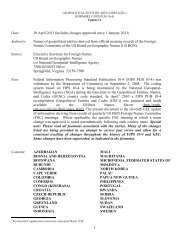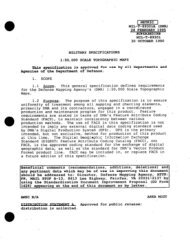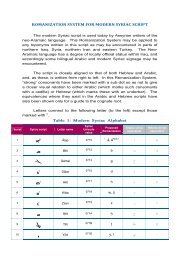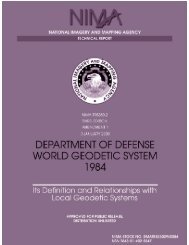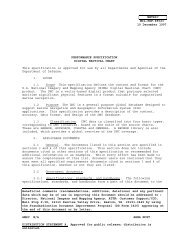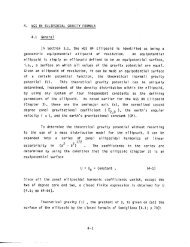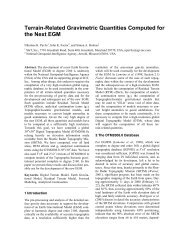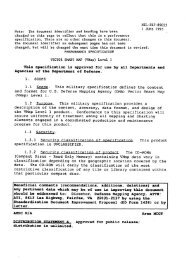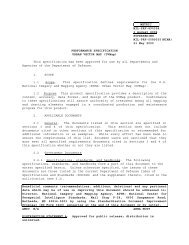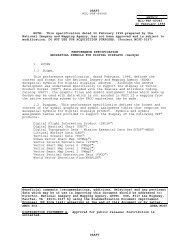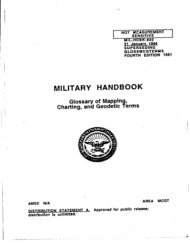Brazil - NGA - National Geospatial-Intelligence Agency
Brazil - NGA - National Geospatial-Intelligence Agency
Brazil - NGA - National Geospatial-Intelligence Agency
Create successful ePaper yourself
Turn your PDF publications into a flip-book with our unique Google optimized e-Paper software.
Approved: FNC 368<br />
26 August 2011<br />
Geographic Names Standardization Policy for <strong>Brazil</strong><br />
United States Board on Geographic Names – Foreign Names Committee<br />
August 2011
1. Introduction<br />
2<br />
Approved: FNC 368<br />
26 August 2011<br />
The standardization policies presented below have been prepared to effect consistent<br />
treatment of geographic name spellings in U.S. Government data bases, publications,<br />
maps, and charts, and are intended to satisfy the statutory requirements levied upon the<br />
U.S. Board on Geographic Names in Public Law 242 - 80 th Congress to develop<br />
principles, policies and procedures for geographic names standardization, and to<br />
promulgate decisions with respect to the principles of geographic nomenclature and<br />
orthography. The policies described herein are limited to geographic names encountered<br />
in <strong>Brazil</strong>, and shall be applied to all <strong>Brazil</strong>ian geographic name and feature records in the<br />
Geographic Names Database maintained for U. S. Government purposes by the <strong>National</strong><br />
<strong>Geospatial</strong>-<strong>Intelligence</strong> <strong>Agency</strong> (<strong>NGA</strong>).<br />
2. Languages and Language Policy in <strong>Brazil</strong><br />
a. Demographics<br />
According to the 2010 CIA World Factbook, the <strong>Brazil</strong>ian population is estimated at 201 million.<br />
The population is ethnically diverse with 53.7% white, 38.5% multiracial, 6.2% black,<br />
and 0.9% described as other (Japanese, Arab, and Amerindian). Roman Catholicism is<br />
the dominant religion, followed by Protestantism. 1<br />
b. Languages<br />
The official language of <strong>Brazil</strong> is Portuguese (ISO 639-3 code: por). <strong>Brazil</strong> is<br />
linguistically diverse with 181 living languages, many of which are indigenous<br />
languages. 2<br />
The linguistic diversity of <strong>Brazil</strong> also extends to European languages and dialects that<br />
were brought to <strong>Brazil</strong> by immigrants. The Hunsrik dialect of German (also known as<br />
Hunsiker and Rio Grande Hunsiker) is spoken by 3 million <strong>Brazil</strong>ians in the states of Rio<br />
Grande do Sul, Santa Catarina, and Paraná. Hunsrik (ISO 639-3 code: hrx) is derived<br />
from the German dialect Hunsrücker (Westpfälzisch) with great influence from<br />
Portuguese. The Talian dialect (also known as Taliano, Venetian, Veneto, or Vèneto) is<br />
spoken in the <strong>Brazil</strong>ian states of Rio Grande do Sul and Santa Catarina by approximately<br />
4 million people. Talian (ISO 639-3 code: vec) is a Gallo-Italian language from Northern<br />
Italy. 3<br />
c. Geographic Names Standardization<br />
The following update summarizes <strong>Brazil</strong>’s geographic names standardization efforts.<br />
1 <strong>Brazil</strong>. The 2010 CIA World Factbook. 8 Nov 2010.<br />
2<br />
Lewis, M. Paul (ed.), 2009. Ethnologue: Languages of the World, Sixteenth edition. Dallas, Tex.: SIL International. Online<br />
version: http://www.ethnologue.com/.<br />
3<br />
Lewis, M Paul. Ethnologue.
This information was included in the 39 th United Nations Group of Experts on<br />
Geographical Names (UNGEGN) Bulletin. 4<br />
3<br />
Approved: FNC 368<br />
26 August 2011<br />
In 2005, <strong>Brazil</strong> began the Project Geographical Names of <strong>Brazil</strong> to standardize<br />
geographical names, restore the historical and cultural value of geographical names, and<br />
promote the interest in <strong>Brazil</strong>ian toponyms. The Geographical Names Database of <strong>Brazil</strong><br />
(BNGB) 5 will provide information of geographical names regarding the name’s<br />
etymology, history, spelling, variants, and associated legislation.<br />
In December 2008, the Committee of Geographical Names was created within the<br />
<strong>National</strong> Commission on Cartography in <strong>Brazil</strong> (CONCAR). The main goal of the<br />
committee is to promote the standardization of geographical names within the <strong>Brazil</strong>ian<br />
territory, establish national principles and policies, promote collaboration between local,<br />
state and federal government agencies, and develop procedures for geographical names<br />
standardization while taking into account the resolutions of the United Nations and<br />
international recommendations and practices.<br />
For more information on the committee’s activities visit:<br />
<br />
3. Toponymic Policies<br />
a. Orthography<br />
Portuguese orthographic conventions are to be followed. For more information, please<br />
refer to Portuguese orthographic reference material such as Portuguese Orthography by<br />
Lambert M. Timpledon, Miriam T. Marseken, and Susan F. Surhone (2010). Over the<br />
decades, the orthographies of European Portuguese and <strong>Brazil</strong>ian Portuguese have been<br />
adjusted and standardized by agreements between the respective governments and<br />
academies.<br />
There is a new agreement to unify the orthography of Portuguese in Angola, <strong>Brazil</strong>, Cape<br />
Verde, Guinea-Bissau, Mozambique, Portugal, Sao Tome and Principe, and Timor-Leste.<br />
This new orthographic agreement became effective on January 1, 2009. In <strong>Brazil</strong>, the<br />
president signed a decree for a period of transition and implementation, valid until 2012,<br />
during which both old and new orthographies will be accepted. 6 See Appendix A for<br />
details on these new orthographic conventions. The effects of these orthographic changes<br />
on geographic names are currently unclear. The elimination of some accent marks could<br />
have a direct influence on geographic names; however, there could also be instances<br />
where changes to the spelling of geographical names also occur.<br />
4 United Nations Group of Experts on Geographical Names (UNGEGN). Bulletin 39. Fall 2010.<br />
. 14 Feb 2011<br />
5 Working Paper No. 40. The Database of Geographical Names in <strong>Brazil</strong>. UNGEGN Twenty-fifth session. Nairobi, 5-25 May 2009. <<br />
http://unstats.un.org/unsd/geoinfo/UNGEGN/docs/25th-gegn-docs/wp%20papers/wp40-database-brazil.pdf >. 14 Feb 2011.<br />
6 Reforma Ortográfica. . 20 Dec 2010.<br />
Academia Brasileira de Letras. . 20 Dec 2010.
4<br />
Approved: FNC 368<br />
26 August 2011<br />
b. Generic Terms<br />
A generic is a term that identifies a feature class. Examples include words such as ‘river,’<br />
‘hill,’ and ‘lake.’ A generic term associated with a specific is considered a true generic<br />
unless map symbology indicates otherwise. Generics are not collected for populated<br />
places in <strong>Brazil</strong>.<br />
Care should be taken when using medium to small-scale map sources, which may show<br />
all inhabited areas as populated places.<br />
A list of generic terminology for <strong>Brazil</strong> is located under Appendix B.<br />
c. Capitalization<br />
Definite articles are used in approved names according to native sources. When source<br />
evidence regarding the capitalization of the definite article is mixed, names of associated<br />
features, if present, will be examined to assist in the decision. When a name is<br />
encountered in all capital letters on native sources, non-initial definite articles will be<br />
rendered in lowercase for the approved form in the database. In the absence of conclusive<br />
evidence non-initial definite articles are written in lowercase letters in the standardized<br />
name form.<br />
d. Numbers<br />
Names containing numerals as integral parts, both cardinal and ordinal, should be treated<br />
according to the following principles:<br />
- Arabic numerals are ordinarily expanded in Portuguese. Examples: 2 Montes (on<br />
source) is rendered Dois Montes. 1 de Abril (on source) is rendered Primeiro de<br />
Abril.<br />
- Roman numerals are retained throughout.<br />
- These principles apply to both name initial and non-initial numerals.<br />
e. Optional Long and Short Forms<br />
Short forms are not added to Variant names and should be removed when a formerly<br />
Approved name becomes a Variant name.<br />
Administrative division names are accorded long and short forms, e.g., Estado do<br />
Amazonas [long form], Amazonas [short form].<br />
Long and short forms of populated places are approved when supported by official<br />
evidence, e.g., São Gabriel da Cachoeira [long form]; São Gabriel [short form].<br />
Railroad station names that appear on official sources with the generic term estação are<br />
given long and short forms as supported by evidence. Example: Estação Macaúbas [long<br />
form]; Macaúbas [short form].
5<br />
Approved: FNC 368<br />
26 August 2011<br />
Where official maps show more than one populated place with the same name in the<br />
same estado (administrative division), a special effort is to be made to obtain<br />
distinguishing long forms from census lists and other official sources.<br />
f. Diacritics<br />
Diacritics are shown in standardized name forms as they appear on native sources and in<br />
accordance with Portuguese orthography. Uppercase letters in standardized name forms<br />
retain diacritics.<br />
In accordance with Portuguese orthography, the following diacritics are encountered in<br />
standardized name forms in <strong>Brazil</strong>:<br />
Character Name Character Unicode Value<br />
Capital A with grave accent À 00C0<br />
Capital A with acute accent Á 00C1<br />
Capital A with circumflex  00C2<br />
Capital A with tilde à 00C3<br />
Capital C with cedilla Ç 00C7<br />
Capital E with grave accent È 00C8<br />
Capital E with acute accent É 00C9<br />
Capital E with circumflex Ê 00CA<br />
Capital I with acute accent Í 00CD<br />
Capital O with grave accent Ò 00D2<br />
Capital O with acute accent Ó 00D3<br />
Capital O with circumflex Ô 00D4<br />
Capital O with tilde Õ 00D5<br />
Capital U with acute accent Ú 00DA<br />
Capital U with dieresis Ü 00DC<br />
Small a with grave accent à 00E0<br />
Small a with acute accent á 00E1<br />
Small a with circumflex â 00E2<br />
Small a with tilde ã 00E3<br />
Small c with cedilla ç 00E7<br />
Small e with grave accent è 00E8<br />
Small e with acute accent é 00E9<br />
Small e with circumflex ê 00EA<br />
Small i with acute accent í 00ED<br />
Small o with grave accent ò 00F2<br />
Small o with acute accent ó 00F3<br />
Small o with circumflex ô 00F4<br />
Small o with tilde õ 00F5<br />
Small u with acute accent ú 00FA<br />
Small u with dieresis ü 00FC
g. Other<br />
6<br />
Approved: FNC 368<br />
26 August 2011<br />
Names containing the conjunction "ou"<br />
Some sources may show two or more names for a feature joined by the conjunction "ou,"<br />
meaning "or" (example: Rio Lunno ou Unho). For the purposes of standardization, only<br />
one name will be selected as the official standard name. The choice of name as standard<br />
will depend on weight of evidence. If there is no further evidence, one should use the<br />
first as the official standard name. In accordance with standard policy, the other names<br />
for the feature will be considered variants.<br />
4. Political Geographic Policy<br />
a. Country Name and Capital<br />
Country Name<br />
Conventional long form: Federative Republic of <strong>Brazil</strong><br />
Conventional short form: <strong>Brazil</strong><br />
Standard long form: República Federativa do Brasil<br />
Standard short form: Brasil<br />
Capital<br />
Approved name: Brasília
. First-order Administrative Divisions<br />
7<br />
Approved: FNC 368<br />
26 August 2011<br />
Name Generic Seat FIPS 10-4 ISO 3166-2<br />
1. Acre estado Rio Branco BR01 BR-AC<br />
2. Alagoas estado Maceió BR02 BR-AL<br />
3. Amapá estado Macapá BR03 BR-AP<br />
4. Amazonas estado Manaus BR04 BR-AM<br />
5. Bahia estado Salvador BR05 BR-BA<br />
6. Ceará estado Fortaleza BR06 BR-CE<br />
7. Distrito Federal distrito Brasília BR07 BR-DF<br />
federal<br />
8. Espírito Santo estado Vitória BR08 BR-ES<br />
9. Goiás estado Goiânia BR29 BR-GO<br />
10. Maranhão estado São Luis BR13 BR-MA<br />
11. Mato Grosso estado Cuiabá BR14 BR-MT<br />
12. Mato Grosso do Sul estado Campo Grande BR11 BR-MS<br />
13. Minas Gerais estado Belo Horizonte BR15 BR-MG<br />
14. Pará estado Belém BR16 BR-PA<br />
15. Paraíba estado João Pessoa BR17 BR-PB<br />
16. Paraná estado Curitiba BR18 BR-PR<br />
17. Pernambuco estado Recife BR30 BR-PE<br />
18. Piauí estado Teresina BR20 BR-PI<br />
19. Rio de Janeiro estado Rio de Janeiro BR21 BR-RJ<br />
20. Rio Grande do Norte estado Natal BR22 BR-RN<br />
21. Rio Grande do Sul estado Porto Alegre BR23 BR-RS<br />
22. Rondônia estado Porto Velho BR24 BR-RO<br />
23. Roraima estado Boa Vista BR25 BR-RR<br />
24. Santa Catarina estado Florianópolis BR26 BR-SC<br />
25. São Paulo estado São Paulo BR27 BR-SP<br />
26. Sergipe estado Aracaju BR28 BR-SE<br />
27. Tocantins estado Palmas BR31 BR-TO<br />
c. Disputed Territories<br />
Note: For the latest country specific boundary dispute information, visit the U.S.<br />
Department of State’s Boundaries and Sovereignty Encyclopedia, or B.A.S.E., at<br />
http://base.us-state.osis.gov/.<br />
There is a territorial dispute between the first-order administrative divisions of Piauí and<br />
Ceará. Features within the disputed areas will receive the FIPS administrative code<br />
BR99. 7<br />
7 República Federativa do Brasil. Instituto Brasileiro de Geografia e Estatística. 2004.
<strong>Brazil</strong> has a boundary dispute with Uruguay at a site called Arroio Invernada. 8<br />
8<br />
Approved: FNC 368<br />
26 August 2011<br />
The dispute that had existed between <strong>Brazil</strong> and Uruguay over the sovereignty of Isla<br />
Brasileña (Ilha Brasileira) at the confluence of Rio Urugai and Rio Quaraí has been<br />
resolved. The U.S. Department of State informed NIMA (<strong>NGA</strong>’s predecessor) on 8 May<br />
1997 that the island belongs entirely to Uruguay. The international boundary in this area<br />
follows the center of the main channel of Río Uruguay north of Isla Brasileña.<br />
d. Abbreviations<br />
The following are common abbreviations found on native source maps and in native<br />
source gazetteers. Please note that abbreviations must be spelled out in the Geographic<br />
Names Database.<br />
Abbreviated Form Unabbreviated Form<br />
A. Arroio<br />
B. Baía<br />
C. Cabo<br />
Cach. Cachoeira<br />
Corr. Córrego<br />
Esc. Escola<br />
Est. Estação<br />
Ig. Igarapé<br />
I(s) Ilha(s)<br />
L. Lago or Lagoa<br />
Lag. Lagoa<br />
M. Monte<br />
Mo. Morro<br />
Pta. Ponta<br />
R. Rio<br />
S. Serra<br />
5. Source Material<br />
The Diretoria do Serviço Geográfico (DSG) and the Instituto Brasileiro de Geografia e<br />
Estatística (IBGE) are the preferred authorities for <strong>Brazil</strong>ian map and chart sources. In<br />
addition, there are other <strong>Brazil</strong>ian government and private agencies that issue material<br />
suitable for use in geographic names collection. The Diretoria de Hidrografia e<br />
Navegação is also a preferred source for nautical charts. The following is a listing of<br />
source material, prioritized according to recommended usage for geographic name<br />
selection. All items are available at the <strong>National</strong> <strong>Geospatial</strong>-<strong>Intelligence</strong> <strong>Agency</strong> (<strong>NGA</strong>)<br />
Research Center.<br />
1. <strong>Brazil</strong>, 1:50,000-scale series, Diretoria do Serviço Geográfico (DSG), 1980-91.<br />
8 Guo Rongxing. Territorial Disputes and Resource Management: A Global Handbook. Nova Science Publishers Inc. 2007. Page 144.
9<br />
Approved: FNC 368<br />
26 August 2011<br />
2. <strong>Brazil</strong>, 1:100,000-scale series, Diretoria do Serviço Geográfico (DSG), 1970's-80’s.<br />
3. <strong>Brazil</strong>, 1:250,000-scale series, Diretoria do Serviço Geográfico (DSG) and<br />
government agencies, 1980-91.<br />
4. Amazonia Legal, 1:3,000,000, Instituto Brasileiro de Geografia e Estatística (IBGE),<br />
1995.<br />
5. <strong>Brazil</strong>, 1:15,000,000, Instituto Brasileiro de Geografia e Estatística (IBGE), 1993.<br />
6. <strong>Brazil</strong>, 1:5,000,000, Instituto Brasileiro de Geografia e Estatística (IBGE), 2004.<br />
7. <strong>Brazil</strong> Atlas, 1:1,000,000, 1971.<br />
8. Instituto Brasileiro de Geografia e Estatística (IBGE) website: www.ibge.gov.br<br />
Other sources of information:<br />
1. BGN Gazetteer of <strong>Brazil</strong>, 1963.<br />
2. BGN Gazetteer of <strong>Brazil</strong> - Supplement, 1992.<br />
3. Dicionário Geográfico Brasileiro, second edition, Pôrto Alegre, 1972.<br />
4. State (estado) maps, various scales and dates.
APPENDIX A - New Orthographic Agreement for<br />
Portuguese Language 9<br />
10<br />
Approved: FNC 368<br />
26 August 2011<br />
1) Accentuation in diphthongs with paroxytone words<br />
Elimination of accent of open diphthongs (when there are two vowels in the same<br />
syllable éi and ói of paroxytone words (words in which the strongest syllable is<br />
the penultimate):<br />
Old New<br />
idéia ideia<br />
bóia boia<br />
asteróide asteroide<br />
Coréia Coreia<br />
platéia plateia<br />
assembléia assembleia<br />
heróico heroico<br />
estréia estreia<br />
paranóia paranoia<br />
Européia Europeia<br />
apóio apoio<br />
jibóia jiboia<br />
jóia joia<br />
2) Circumflex accent in êem and ôo<br />
Elimination of circumflex accent in words ending in êem and ôo (ôos):<br />
Old New<br />
crêem creem<br />
lêem leem<br />
dêem deem<br />
vêem veem<br />
prevêem preveem<br />
enjôo enjoo<br />
vôos voos<br />
3) Acute accent in some paroxytone words<br />
Elimination of accent in strong i and u after diphthongs (junction of two vowels)<br />
in paroxytone words. Note: if the i and u are in the last syllable, the accent will<br />
remain. Example: tuiuiú or Piauí.<br />
Old New<br />
baiúca baiuca<br />
bocaiúva bocaiuva<br />
9 Reforma Ortográfica. . 20 Dec 2010.<br />
Academia Brasileira de Letras. . 20 Dec 2010.
feiúra feiura<br />
11<br />
Approved: FNC 368<br />
26 August 2011<br />
4) Differential accent<br />
Elimination of differential accent (the one used to distinguish vocal tones). Note:<br />
No differential accent elimination in pôr (verb) / por (preposition) and pôde<br />
(preterit) / pode (present tense). Fôrma: to differentiate forma; circumflex accent<br />
may be used to differentiation.<br />
Old New<br />
pêlo pelo<br />
pára para<br />
pólo polo<br />
pêra pera<br />
côa coa<br />
5) Acute accent in strong u<br />
Elimination of acute accent in strong u in verb groups: gue, gui, que, qui.<br />
Examples: averiguar, apaziguar, redarguir, enxaguar (all other accent rules remain<br />
the same):<br />
Old New<br />
averigúe averigue<br />
apazigúe apazigue<br />
ele argúi ele argui<br />
enxagúe você enxague você<br />
6) Alphabet: Addition of Three Letters<br />
The alphabet now consists of 26 letters after the inclusion of k, w, and y.<br />
7) Hyphen: Elimination in Some Cases<br />
a) Elimination occurs when the prefix ends with a vowel and the second element<br />
starts with a different vowel:<br />
Old New<br />
extra-escolar extraescolar<br />
aero-espacial aeroespacial<br />
auto-estrada autoestrada<br />
b) Elimination occurs when the second element starts with s or r, making it<br />
necessary to duplicate that consonant. Note: The hyphen will be kept when the<br />
prefix ends in r- examples: hiper-requintado, inter-resistente, super-vista.<br />
Old New<br />
anti-religioso antirreligioso
anti-semita antissemita<br />
contra-regra contrarregra<br />
infra-som infrassom<br />
12<br />
Approved: FNC 368<br />
26 August 2011<br />
8) Dieresis: Elimination of the Dieresis<br />
The dieresis is eliminated in all words. Note: the dieresis remains in names like<br />
Möller and Citröen.<br />
Old New<br />
freqüente frequente<br />
lingüiça linguiça<br />
seqüestro sequestro<br />
APPENDIX B – Glossary Generic Terms<br />
Generic Feature Designation Name Feature Designation Code<br />
açude reservoir RSV<br />
água stream STM<br />
aparados escarpment ESCU<br />
arquipélago islands ISL<br />
arroio stream STM<br />
atol atoll ATOL<br />
baia bay BAY<br />
baixo reef RF<br />
banco marine bank BNK<br />
banhado stream marsh STM<br />
barra entrance BAR<br />
barragem reservoir RSV<br />
bracinho distributary STMD<br />
braço stream STMD<br />
braço de mar inlet INLT<br />
brejão, brejo intermittent stream STMI<br />
cabeceira stream STM<br />
cabeços hills HLL<br />
cabo cape CAPE<br />
cachoeira waterfall FLLS<br />
calhau rock in water RK<br />
campina plain PLN<br />
campos upland UPLD<br />
canal stream CNL<br />
cêrro hill HLL<br />
chapada plain PLN<br />
chapadão spur SPUR
contraforte ridge RDGE<br />
cordilheira hill range HLL<br />
corixo stream STM<br />
corredeira rapids RPDS<br />
córrego stream STM<br />
distrito federal federal district ADM1<br />
enseada cove COVE<br />
espigão upland UPLD<br />
estado first-order administrative division ADM1, state<br />
estação railroad station RSTN<br />
fonte termal hot springs SPNT<br />
furo stream STM<br />
galho stream STM<br />
garganta gorge GRGE<br />
grota, grotão stream STM<br />
igarapé stream STM<br />
ilha island ISL<br />
ilhéu island ISL<br />
ilhota island ISL<br />
ilhote island ISL<br />
lago lagoon LGN<br />
lago lake LK<br />
lagoa intermittent lake LKI<br />
lagoa lake LK<br />
lagoa pond PND<br />
laje reef RF<br />
lajeado stream STM<br />
mar marine channel CHNM<br />
marimbu stream STM<br />
monte hill HLL<br />
monte mountain MT<br />
monte upland UPLD<br />
morro headland HDLD<br />
morro hill HLL<br />
morro mountain MT<br />
morro peak PK<br />
morro ridge RDGE<br />
morro upland UPLD<br />
município second administrative division AMD2<br />
outeiro hill HLL<br />
paraná distributary STMD<br />
parcel shoal SHOL<br />
passagem reach RCH<br />
pedra hill HLL<br />
pedra mountain MT<br />
pedra rock in water RK<br />
13<br />
Approved: FNC 368<br />
26 August 2011
pedral rock in water RK<br />
pico hill HLL<br />
pico mountain MT<br />
pico peak PK<br />
planalto plateau PLAT<br />
planalto upland UPLD<br />
plataforma railroad stop RSTP<br />
ponta point PT<br />
pontal point PT<br />
praia beach BCH<br />
quedas waterfall FLLS<br />
quedas rapids RPDS<br />
raso upland UPLD<br />
recife reef RF<br />
região region RGN<br />
represa reservoir RSV<br />
reservatório reservoir RSV<br />
restinga barrier beach BCH<br />
restinga sand area SAND<br />
riachão intermittent stream STMI<br />
riachão stream STM<br />
riacho intermittent stream STMI<br />
14<br />
Approved: FNC 368<br />
26 August 2011



